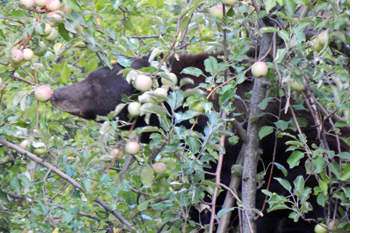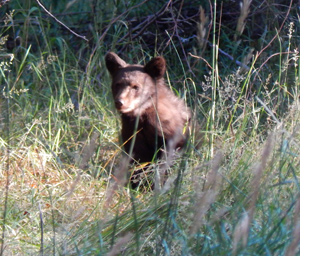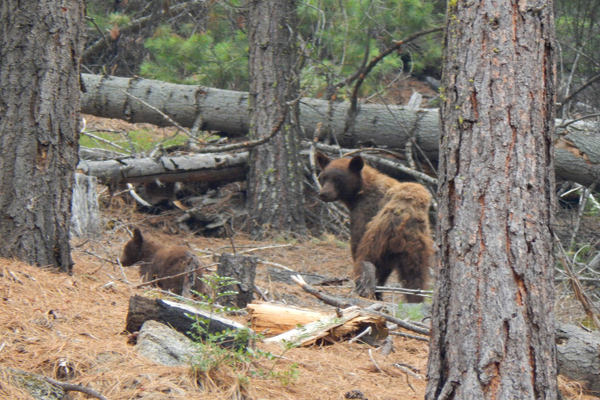 What was not particularly distinct though was the way in which North American wildlife was ruthlessly hunted and quickly deprived of habitat and living space by settlers as forests gave way to agriculture. Despite cultural connections dating back to the "Old World," bears at first were not spared from this extermination. As powerful, cunning, and sometimes dangerous animals (indeed, also a somewhat liminal figure that embodies both human and animal traits, not unlike the frontiersman), bears made the perfect antagonists for the American frontiersmen like Daniel Boone, who, while exploring west of the Blue Ridge Mountains, carved into a tree in Tennessee "D. Boon Cilled a. Bar on tree in the year 1760." [sic] Killing a bear had certain economic reasons as there was also a demand for bear meat and also a particular symbolic resonance;killing a bear was the American equivalent of slaying a dragon in the wilds of the frontier. Perhaps the most well known in popular culture of the many spiritual descendants of Boone was David Crockett, immortalized at the Alamo and thenceforth in books, movies, TV and various commercial products. I'm sure even if you never saw the Disney TV show you can recall the famous refrain from the theme song; "Born on a mountaintop in Tennessee, killed a bar [bear] when he was only three." Obviously these popular images of Crockett (and to be honest he was far more the showman and less the explorer of Boone's caliber) show him fighting a grizzly bear, which never existed on any mountaintop in Tennessee.
What was not particularly distinct though was the way in which North American wildlife was ruthlessly hunted and quickly deprived of habitat and living space by settlers as forests gave way to agriculture. Despite cultural connections dating back to the "Old World," bears at first were not spared from this extermination. As powerful, cunning, and sometimes dangerous animals (indeed, also a somewhat liminal figure that embodies both human and animal traits, not unlike the frontiersman), bears made the perfect antagonists for the American frontiersmen like Daniel Boone, who, while exploring west of the Blue Ridge Mountains, carved into a tree in Tennessee "D. Boon Cilled a. Bar on tree in the year 1760." [sic] Killing a bear had certain economic reasons as there was also a demand for bear meat and also a particular symbolic resonance;killing a bear was the American equivalent of slaying a dragon in the wilds of the frontier. Perhaps the most well known in popular culture of the many spiritual descendants of Boone was David Crockett, immortalized at the Alamo and thenceforth in books, movies, TV and various commercial products. I'm sure even if you never saw the Disney TV show you can recall the famous refrain from the theme song; "Born on a mountaintop in Tennessee, killed a bar [bear] when he was only three." Obviously these popular images of Crockett (and to be honest he was far more the showman and less the explorer of Boone's caliber) show him fighting a grizzly bear, which never existed on any mountaintop in Tennessee.
A similar frontier character, also somewhat clouded by mythology, but related here to Yosemite, was John "Grizzly" Adams, an unsuccessful 49er who first captured a female grizzly bear in modern-day Montana, which he partially tamed to follow him and be ridden like a beast of burden. He captured two grizzly cubs in the vicinity of Yosemite Valley, including one he named "Benjamin Franklin," which saved his life from another female grizzly's attack. With a growing menagerie he began displaying his bears at shows and eventually relocated to a museum in San Francisco. To the surprise of nobody, Adams died from complications resulting from the many serious injuries he received from wrestling with performing bears, especially one named "General Fremont" who cracked Adams' skull open several times during exhibitions. Like Boone and Crockett before him, Adams was a liminal character straddling both civilization and the wild and by "taming" his bears. He demonstrated a similar mastering and domination of the North American continent, although perhaps to a less lethal regard than Boone or Crockett, which may have reflected the passing of the frontier and a desire to see nature "tamed" rather than completely destroyed, at least as popular entertainment.
 As America became more urbanized and industrialized, and especially after the frontier "closed" in 1890 and once common animals such as elk, bison and even deer became scarce, the nascent conservation movement took root in the United States, which sought to re-evaluate wilderness and wildlife in a different manner other than pure antagonism or commercial exploitation. The turn of the last century saw the origin of the first national parks, the beginning of the Forest Service, the creation of national wildlife refuges, the Sierra Club, and the American Bison Society. Perhaps the President we most often associate with the outdoors and conservation is Theodore Roosevelt. Few others have been as intrinsically associated with bears as much as he, although unintentionally. While on a hunt in Mississippi in 1902 a black bear had been chased by hounds, clubbed, and lassoed to a tree. Roosevelt at this time had not made a kill so he was invited to shoot the bear. However, Roosevelt considered this unsportsmanlike and refused to do so, although he did say the bear should be shot to be put out of its misery.
As America became more urbanized and industrialized, and especially after the frontier "closed" in 1890 and once common animals such as elk, bison and even deer became scarce, the nascent conservation movement took root in the United States, which sought to re-evaluate wilderness and wildlife in a different manner other than pure antagonism or commercial exploitation. The turn of the last century saw the origin of the first national parks, the beginning of the Forest Service, the creation of national wildlife refuges, the Sierra Club, and the American Bison Society. Perhaps the President we most often associate with the outdoors and conservation is Theodore Roosevelt. Few others have been as intrinsically associated with bears as much as he, although unintentionally. While on a hunt in Mississippi in 1902 a black bear had been chased by hounds, clubbed, and lassoed to a tree. Roosevelt at this time had not made a kill so he was invited to shoot the bear. However, Roosevelt considered this unsportsmanlike and refused to do so, although he did say the bear should be shot to be put out of its misery.
 As America became more urbanized and industrialized, and especially after the frontier "closed" in 1890 and once common animals such as elk, bison and even deer became scarce, the nascent conservation movement took root in the United States, which sought to re-evaluate wilderness and wildlife in a different manner other than pure antagonism or commercial exploitation. The turn of the last century saw the origin of the first national parks, the beginning of the Forest Service, the creation of national wildlife refuges, the Sierra Club, and the American Bison Society. Perhaps the President we most often associate with the outdoors and conservation is Theodore Roosevelt. Few others have been as intrinsically associated with bears as much as he, although unintentionally. While on a hunt in Mississippi in 1902 a black bear had been chased by hounds, clubbed, and lassoed to a tree. Roosevelt at this time had not made a kill so he was invited to shoot the bear. However, Roosevelt considered this unsportsmanlike and refused to do so, although he did say the bear should be shot to be put out of its misery.
As America became more urbanized and industrialized, and especially after the frontier "closed" in 1890 and once common animals such as elk, bison and even deer became scarce, the nascent conservation movement took root in the United States, which sought to re-evaluate wilderness and wildlife in a different manner other than pure antagonism or commercial exploitation. The turn of the last century saw the origin of the first national parks, the beginning of the Forest Service, the creation of national wildlife refuges, the Sierra Club, and the American Bison Society. Perhaps the President we most often associate with the outdoors and conservation is Theodore Roosevelt. Few others have been as intrinsically associated with bears as much as he, although unintentionally. While on a hunt in Mississippi in 1902 a black bear had been chased by hounds, clubbed, and lassoed to a tree. Roosevelt at this time had not made a kill so he was invited to shoot the bear. However, Roosevelt considered this unsportsmanlike and refused to do so, although he did say the bear should be shot to be put out of its misery.
This incident became a popular political cartoon drawn by Clifford Berryman, which then inspired toymaker Morris Michtom to make a stuffed bear with his wife Rose that he advertised as "Teddy's Bear" (Roosevelt himself disliked the nickname "Teddy"). Other manufacturers joined in this burgeoning craze and even Roosevelt himself used a bear as a prop when he ran for re-election. To this day a teddy bear is a staple of childhood worldwide.
From an antagonist that had to be defeated to make way for Manifest Destiney, to a figure of comfort for small children (and even some adults), the cultural value of bears changed radically from the 18th to the early 20th Century. However, this coincided with the near extirpation of all bears from their historic range. Bears became a cute commodity only after the majority of Americans no longer had to deal with them as wild animals.
The American frontier is long gone and Frederick Jackson Turner's essay about the fundamental American character and its relation to the frontier has somewhat fallen out of popular favor. However, for myself and certainly I'd imagine many other park visitors, seeing wild bears at our national parks, areas themselves where the boundary between civilization and wilderness becomes blurred, invokes a distinct feeling of pride and patriotism for this uniquely American form of conservation that began here in Yosemite Valley.

